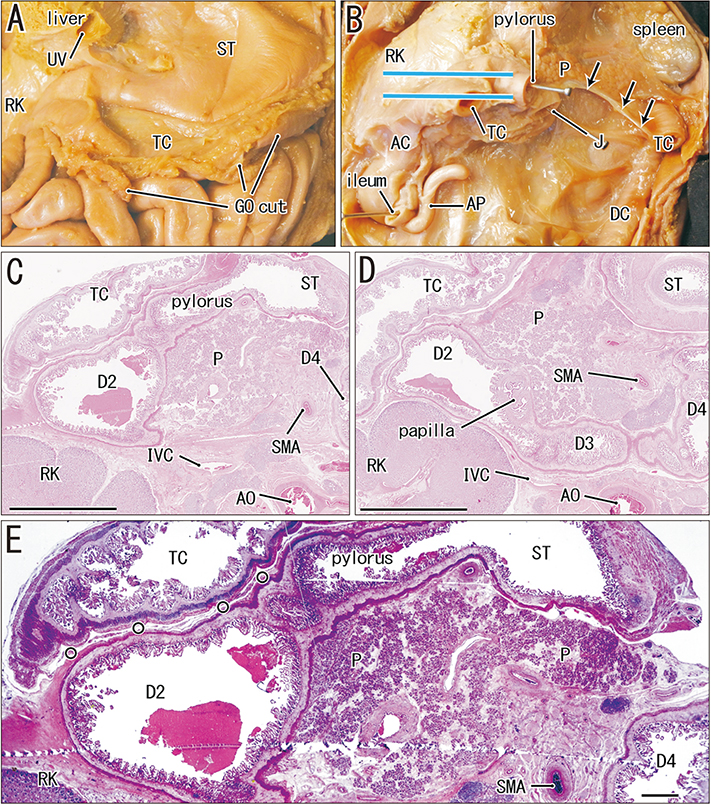Anat Cell Biol.
2019 Dec;52(4):443-454. 10.5115/acb.19.112.
Topographical anatomy of the greater omentum and transverse mesocolon: a study using human fetuses
- Affiliations
-
- 1Division of Common Curriculum, Hokkaido Chitose College of Rehabilitation, Chitose, Japan.
- 2Department of Anatomy, Jeonbuk National University Medical School, Jeonju, Korea. 407kk@hanmail.net
- 3Department of Maxillofacial Anatomy, Graduate School of Tokyo Medical and Dental University, Tokyo, Japan.
- 4Division of Internal Medicine, Jikou-kai Clinic of Home Visits, Sapporo, Japan.
- 5Department of Anatomy and Embryology, Faculty of Medicine, Complutense University, Madrid, Spain.
- KMID: 2466698
- DOI: http://doi.org/10.5115/acb.19.112
Abstract
- The greater omentum covers the transverse colon from the anterior side in adults, but people might believe the morphology stable once established during fetal life. Sections from 49 midterm and 17 late-stage human fetuses, of gestational ages (GA) 8-15 and 30-38 weeks, respectively, showed complete fusion between the greater omentum and transverse mesocolon after physiological herniation at GA 8-9 weeks; the transverse colon attaching to the anterior aspect of the gastric antrum and pylorus at GA 10-15 weeks; the colon pushing the pylorus or superior portion of the duodenum upward (at GA 10-15 weeks and 30-38 weeks); and the greater omentum without covering the greater portion of the jejunum and ileum but shifted leftward (at GA 30-38 weeks). These subsequent topographical variations of the transverse colon with the stomach and duodenum included the colon tightly fusing with the stomach by a fibrous tissue and; the greater omentum and/or the mesocolon wedged between the stomach and transverse colon. Therefore, in combination, the colon was partly separated from the greater omentum. Moreover, at GA 30-38 weeks, the duodenum consistently showed a horizontal loop in contrast to the usual C-loop in the frontal plane. Consequently, after a complete fusion occurred once between the greater omentum and transverse mesocolon, the topographical change of the upper abdominal viscera seemed to modify, change or even break the initial fusion of the peritoneum. A logical lamination of the peritoneum seemed not to simply connect with the surgical application.
Keyword
MeSH Terms
Figure
Reference
-
1. Carlson BM. Human embryology and developmental biology. 2nd ed. Philadelphia, PA: Mosby Elsevier;2009. p. 353–392.2. Schoenwolf GC, Bleyl SB, Brauer PR, Francis-West PH. Larsen's human embryology. 4th ed. Philadelphia, PA: Churchill Livingstone Elsevier;2009. p. 435–477.3. Sugarbaker PH. Peritonectomy procedures. Ann Surg. 1995; 221:29–42.4. Kurokawa Y, Doki Y, Mizusawa J, Terashima M, Katai H, Yoshikawa T, Kimura Y, Takiguchi S, Nishida Y, Fukushima N, Iwasaki Y, Kaji M, Hirao M, Katayama H, Sasako M. Bursectomy versus omentectomy alone for resectable gastric cancer (JCOG1001): a phase 3, open-label, randomised controlled trial. Lancet Gastroenterol Hepatol. 2018; 3:460–468.5. Cho BH, Kimura W, Song CH, Fujimiya M, Murakami G. An investigation of the embryologic development of the fascia used as the basis for pancreaticoduodenal mobilization. J Hepatobiliary Pancreat Surg. 2009; 16:824–831.6. Kim WK, Kim H, Ahn DH, Kim MH, Park HW. Timetable for intestinal rotation in staged human embryos and fetuses. Birth Defects Res A Clin Mol Teratol. 2003; 67:941–945.7. Metzger R, Metzger U, Fiegel HC, Kluth D. Embryology of the midgut. Semin Pediatr Surg. 2011; 20:145–151.8. Soffers JH, Hikspoors JP, Mekonen HK, Koehler SE, Lamers WH. The growth pattern of the human intestine and its mesentery. BMC Dev Biol. 2015; 15:31.9. Ueda Y, Yamada S, Uwabe C, Kose K, Takakuwa T. Intestinal rotation and physiological umbilical herniation during the embryonic period. Anat Rec (Hoboken). 2016; 299:197–206.10. Cho BH, Kim JH, Jin ZW, Wilting J, Rodríguez-Vázquez JF, Murakami G. Topographical anatomy of the intestines during in utero physiological herniation. Clin Anat. 2018; 31:583–592.11. Rigoard P, Haustein SV, Doucet C, Scepi M, Richer JP, Faure JP. Development of the right colon and the peritoneal surface during the human fetal period: human ontogeny of the right colon. Surg Radiol Anat. 2009; 31:585–589.12. Kim JH, Han EH, Jin ZW, Lee HK, Fujimiya M, Murakami G, Cho BH. Fetal topographical anatomy of the upper abdominal lymphatics: its specific features in comparison with other abdominopelvic regions. Anat Rec (Hoboken). 2012; 295:91–104.13. Kaigai N, Nako A, Yamada S, Uwabe C, Kose K, Takakuwa T. Morphogenesis and three-dimensional movement of the stomach during the human embryonic period. Anat Rec (Hoboken). 2014; 297:791–797.14. Jeong YJ, Cho BH, Kinugasa Y, Song CH, Hirai I, Kimura W, Fujimiya M, Murakami G. Fetal topohistology of the mesocolon transversum with special reference to fusion with other mesenteries and fasciae. Clin Anat. 2009; 22:716–729.15. Culligan K, Remzi FH, Soop M, Coffey JC. Review of nomenclature in colonic surgery: proposal of a standardised nomenclature based on mesocolic anatomy. Surgeon. 2013; 11:1–5.16. Culligan K, Walsh S, Dunne C, Walsh M, Ryan S, Quondamatteo F, Dockery P, Coffey JC. The mesocolon: a histological and electron microscopic characterization of the mesenteric attachment of the colon prior to and after surgical mobilization. Ann Surg. 2014; 260:1048–1056.17. Sato Y, Matsuki S, Yamamoto T, Goto H. Adhesion of the greater omentum seen in adult cadavers. Nihon Univ J Med. 1960; 19:3384–3391.
- Full Text Links
- Actions
-
Cited
- CITED
-
- Close
- Share
- Similar articles
-
- A Case of Pseudocyst Originated from Ectopic Pancreas of Transverse Mesocolon Associated with Colonic Duplication
- Anomalous peritoneal band connecting greater omentum to the ascending colon: a possible cause for dilation of ascending colon
- Absence of transverse colon, persistent descending mesocolon, displaced small and large bowels: a rare congenital anomaly with a high risk of volvulus formation
- Primary Multiple Mesenteric Liposarcoma of the Transverse Mesocolon
- A Case of Huge Cystic Lymphangioma of the Greater Omentum










